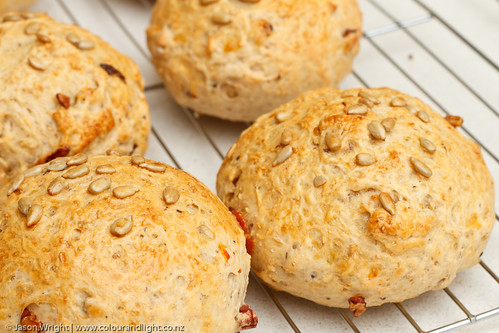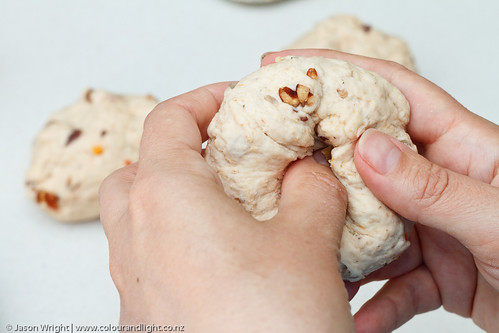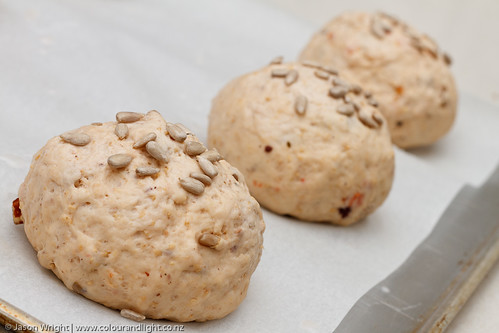
Have you ever made your own bread? It's one of those challenges you step up to, and then find it's so easy you can't believe it's taken you so long.
First, a disclaimer: this is not the same as store-bought bread. You need to eat it within a day or two, or it will be stale. The good news is that this is not store bought bread. It is doughy, and yeasty, and tastes like real bread. You can eat it fresh, or toast it, or make hamburgers with it, and you can add nothing at all, or whatever you like - because you are in charge.
All you need to know is the basic ratio of 5:3. That's 5 parts flour to 3 parts water. Just add yeast and salt, and a little elbow grease.
Using ratios means you need to weigh your ingredients. With a scale. I am going to preach endlessly about the virtue of scales this year, like any newly-converted devotee. If you want the full story, you can buy the book, but basically I learned this year that a cup of flour can vary from 110 to 160g depending on how much air is in it and what kind of cup you are using (the US standard "cup" is 240mL, Australia/NZ use 250mL. Some older measures are different again.) A scientist at heart, I can no longer trust recipes, especially when baking, if they are measured in cups - what kind of cup? Weights are so precise!
A ratio also gives you the basic formula, in a way that allows you to make changes once you understand the role each ingredient plays. Here, I've switched a third of the flour for wholemeal, and added a little milk instead of water to see what happened (not much, though in theory it should soften the bread a little).
My yeast calls for 3 cups of flour per sachet (I use active yeast, no preparation required), so I used this as the base of my ratio. 3 cups = 3 x 150g = 450g. Flour is the "5" in the ratio, so I divided 450 by 5, then multiplied by 3 to get the water ratio = 270g.

450g flour, 270g water, 1 sachet active yeast, and 1-2 tsp salt.
Give it a bit of a stir in the bowl to bring it together, then turn it onto a flat, clean surface.

Knead it until smooth, and then keep going for a few more minutes (if your arms don't hurt, you are doing it wrong. Or you're more fit than I am!)

Form a ball, and place it in a clean bowl lightly greased with olive oil. Cover with a damp teatowel and leave in a warm spot (like the floor of your bedroom if the aircon happens to be on in the lounge) until it doubles in size - usually a couple of hours, but this depends on the temperature, and the age of your yeast.


Punch the air out of the ball, and knead again for a minute. This is a good time to add any "extras" you want to throw in. I couldn't make my mind up, so added olives, semi-dried tomatoes, pecans, and sunflower seeds - about half a cup in total, chopped.

Form rolls. I find that about 130g per roll yields a sandwich-sized roll (probably need half again or even double for a burger bun). Bear in mind that these are more dense than supermarket rolls, so quite filling!
A trick I learned working in a bakery in my youth is to form the roll by folding the dough in to the centre, turning it as you go. This pushes the dough in the direction you want it to rise, promoting even rising. Like so:


Place on a greased tray, brush with water, and leave to double in size again (about an hour).

Brush with milk, or egg wash, sprinkle with extra seeds if you like, then bake at 200C for 12-15 minutes (bread is ready if you turn it upside down and knock on it, and it sounds hollow.)

Best enjoyed hot, with lots of butter!
YUM! I'd say we make bread once or twice a week - typically rolls to go with soup, and pizza bases on Friday nights! Sometimes I get the boy to make a bit of extra dough so we can have cinnamon buns for breakfast on Saturdays. Bread - so many uses. I find kneading the most tedious part of bread making - like going to the gym, it's never as bad as you remember so you just have to get on with it. Italian women say kneading dough helps keep your assets perky. Or you can do what I do and convince your other half that if they want hot bread they have to contribute by doing the kneading. Or buy a food processor with a dough hook (definitely my first purchase when I'm home from my OE). Have you made any sourdoughs from culture, Jan? My dad has heaps stacked in his fridge in Dunedin, but its not something I've done myself yet.
ReplyDelete